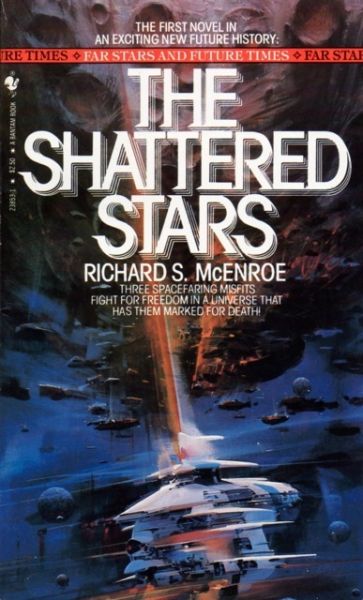Just a Soul That’s Changing Its Shape
The Shattered Stars
By Richard S. McEnroe

22 Aug, 2019
Richard S. McEnroe’s 1984 The Shattered Stars is a standalone (ish) SF novel which takes place in McEnroe’s Far Stars and Future Times setting.
Moses Callahan is the proud owner of the independent trader Wild Goose, which is another way of saying he is a cash-short, desperate man pushed into an economic corner by larger, richer concerns who can afford ships with up-to-date tech. Just the sort of captain who might be greedy enough that he wouldn’t examine closely a chance to earn some quick cash.
Might.
Axyll Jakubowski, of Outward Bound Transfers and Storage, offers Moses a deal too good to be true. Jakubowski’s money is good but Moses has been a space trader long enough to pick up on the disquieting vibes the man gives off. Nonetheless Moses agrees to the charter.
Moses’ new hire ex-marine-turned-pilot Deacon Halloran has heard rumours about the cargo for which Axyll has been trying to find a shipper, rumours he passes on to Moses. Deacon has an assortment of useful skills, which he uses to surreptitiously examines Axyll’s mysterious package. It’s a Bethe trigger, the WMD’s WMD.
Axyll has a plausible explanation for how he got the trigger (he duped the League of Humanity, a terrorist organization, into using him as a middleman to move the stolen trigger for them) and what he plans to use it for (space mining) but those are probably lies. Even if they were not, the involvement of the League is a giant red flag. Moses could decline the deal but then he’d lose the Goose. He could go to the authorities but then the League would probably kill him. The safest bet is to accept the package and its minders Orange and Nullman, then keep an eye out for an escape.
Axyll soon becomes the guest of honour in a body bag. The police presence at his home suggests his death was not due to natural causes. More reason for the crew of the Goose to play it safe.
Moses’ antisocial engineer Mitsuko “Spooky” Tamura has a much clearer, more alarming view of what’s going on than a simple matter of space terrorists, greedy merchants, and super-weapons. She’s a dropout from the Institute, which finds, trains, and exploits telepaths like Mitsuko. She has left the abusive training, preferring the ongoing pain of living in a world of shouting minds.
Some telepaths, like James Emerson White, have evaded the Institute entirely and become monsters. White is the plotter behind Axyll, Orange, and Nullman. The Institute knows that White is out there and must be stopped, but they are too afraid of him to do it themselves. They ask Mitsuko to deal with the current crisis.
Mitsuko could tell captain and shipowner Moses everything she knows, but that would require admitting that she is a telepath and that she’s been reading Moses’ mind the whole time she was on board ship. Not telling Moses what she knows may have worse consequences.
Orange and Nullman, White’s agents aboard ship have their own agenda: hijack the Wild Goose.
~oOo~
This novel could easily be a fictionalized version of a Traveller adventure run by a very unkind GM. Anyone who has found themselves playing a middle-aged merchant who mustered out with an aging ship, a gigantic mortgage, and mounting operational costs would find this passage at the beginning of the book familiar.
Suddenly all that breathing and eating became a life-support replenishment invoice. Those protecting bulkheads hid structural support members that had to be inspected and recertified by a licensed and commensurately expensive naval surveyor. Engines became fuel costs and a ten-thousand-hour service charge. Then there were berth fees, entry fees, value-added tax on cargo transactions, customs “courtesy” fees, outright bribes to the longshoremen’s union — and Moses Callahan wound up sitting in the deepest corner of the Hybreasil in-port bar complex, wondering whether to have another beer or have his good uniform cleaned and pressed before heading out-port to try to unearth a cargo Celtic Crescent or Western Galactic might have overlooked.
In McEnroe’s setting independent traders are doomed from the start. They don’t have the resources to purchase new tech or the economics of scale to compete with the big guys. Anyone setting out as an independent trader will eventually go broke. As I said, sadistic GM.
While there were no sequels, a much younger Moses is a supporting character in 1985’s Skinner. Young Moses is a sunny optimist whose future will be a lot less rewarding than he expects.
This book is extraordinarily derivative. Long-time SF readers may find it entertaining to work out the sources. Heinlein’s powered armour puts in an appearance; the Institute seems to be a nastier version of the psionic authorities in James H. Schmitz’ fiction; and Moses himself could be a depressing take on Norton’s Free Traders.
The prose is workmanlike, although at 182 pages the book itself is oddly short for a 1980s novel. In length as in plot, the book reads like a throwback to earlier times.
What McEnroe had intended to do with this setting is unclear. He published only three novels in this series (two of which had been reworked from shorter pieces). To the best of my knowledge McEnroe’s career as an SF writer ended in 1985. That has always puzzled me. His SF would seem to have been a good fit for Baen; he had personal connections to Baen authors. His first novels were work-for-hire novels in Niven and Pournelle’s Buck Rogers setting; and his sole anthology, 1981’s Proteus: Voices for the 80’s, was drawn from material originally acquired for Destinies. Did some personal difficulty intervene? Did he decide on another career? If you know, you can tell me about it in comments.
The Shattered Stars is out of print.
